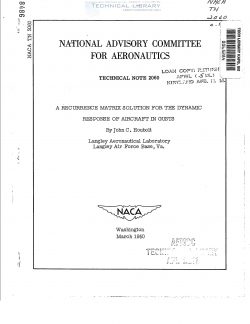naca-tn-2060
- Version
- 94 Downloads
- 3.31 MB File Size
- 1 File Count
- December 9, 2016 Create Date
- December 9, 2016 Last Updated
National Advisory Committee for Aeronautics, Technical Notes - A Recurrence Matrix Solution for the Dynamic Response of Aircraft in Gusts

A systematic procedure is developed for the calculation of the
structural response of aircraft flying through a gust by use of differ-
ence equations and matrix notation. The use of difference equations in
the solution of dynamic problems is first illustrated by means of a
simple-damped-oscillator example. A detailed analysis is then given
which leads to a recurrence matrix equation for the determination of
the response of an airplane in a gust. The method takes into account
wing bending and twisting deformations, fuselage deflection, vertical
and pitching motion of the airplane, and some tail forces. The method
is based on aerodynamic strip theory, but compressibility and‘three-
dimensional aerodynamic.effects can be taken into account approximately
by means of over-all corrections. Either a sharp-edge gust or a gust
of arbitrary shape in the spanwise or flight directions may be treated.
In order to aid in the application of the method to any specific case,
a suggested computational procedure is included.
The possibilities of applying the method to a variety‘of transient
aircraft problems, such as landing, are brought out. A brief review of
matrix algebra, covering the extent to which it is used in the analysis,
is also included.
In the problem of an airplane flying through gusts, accurate
predictions of stresses are not always Obtained if the interaction
between aerodynamic loads and structural deformations is not considered.
The present paper gives a method for determining the dynamic response
of aircraft in gusts in which this interaction is considered. An
approach is employed which is a departure from the usual modal type of
solution. The time derivatives in the integro-differential equations
of motion of the airplane are replaced by appropriate difference
expressions and use is made of matrix notation to express conveniently
the conditions of equilibrium at a number of points along the wing span.
The result is a systematic procedure which is complete and general in
form. The airplane is assumed to be free to translate and pitch. Wing
bending, wing twist, and fuselage flexibility are all included. Tail
forces due to vertical motion, angle of attack, and gust penetration are
also included in the analysis.
| File | Action |
|---|---|
| naca-tn-2060 A Recurrence Matrix Solution for the Dynamic Response of Aircraft in Gusts.pdf | Download |

Comment On This Post